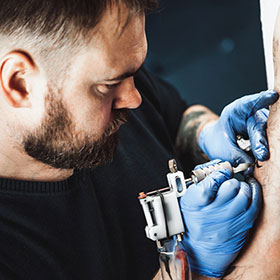Cosmetic tattoos have grown in popularity. They offer long-lasting beauty enhancements.
People seek ways to simplify daily routines. Cosmetic tattoos provide a solution. These tattoos mimic makeup, offering a polished look. They save time, ensuring you wake up looking great. From eyebrows to lips, these techniques can enhance various features. Each method has its own benefits and considerations.
Our guide will explore these techniques. It will help you understand what to expect. By the end, you’ll know which options fit your needs. Dive in to discover the world of cosmetic tattoos.
Introduction To Cosmetic Tattoos
Cosmetic tattoos offer a way to enhance facial features with semi-permanent makeup. Techniques cover eyebrows, eyeliner, and lips, creating natural-looking results. This guide provides essential tips for those interested in exploring cosmetic tattoos.
Cosmetic tattoos have gained popularity in recent years. These tattoos enhance facial features and save time on daily makeup routines. They offer a semi-permanent solution to those who want to look their best without the fuss.What Are Cosmetic Tattoos?
Cosmetic tattoos are also known as permanent makeup or micropigmentation. They involve implanting pigment into the skin’s dermal layer. A skilled technician uses a fine needle or blade for precise application. Common areas for cosmetic tattoos include eyebrows, eyeliner, and lips.Benefits Of Cosmetic Tattoos
Cosmetic tattoos offer several benefits. First, they save time. No need to apply daily makeup. Second, they provide a consistent look. Your eyebrows, eyeliner, and lips always appear perfect. Third, they boost confidence. Many people feel more attractive with enhanced features. Finally, they are water-resistant. Swim or sweat without worrying about smudging. “`Types Of Cosmetic Tattoos
Cosmetic tattoos have gained popularity for their ability to enhance natural beauty. These tattoos are semi-permanent and offer a lasting solution for makeup. In this guide, we will explore the types of cosmetic tattoos. Each type provides a unique way to accentuate different facial features.
Eyebrow Tattoos
Eyebrow tattoos are designed to give you well-defined brows. This technique helps fill in sparse areas. It can also create a more symmetrical look. There are different methods, such as microblading and shading. Microblading uses fine needles to mimic hair strokes. Shading creates a soft, powdery effect. Both methods can be combined for a natural appearance.
Eyeliner Tattoos
Eyeliner tattoos add definition to your eyes. This technique can make your lashes look fuller. It eliminates the need for daily eyeliner application. There are different styles, from subtle lash enhancements to bold lines. The pigment is applied along the lash line. This creates a smudge-proof, waterproof line. It can last for years with proper care.
Lip Tattoos
Lip tattoos enhance the shape and color of your lips. This technique can correct asymmetry and add fullness. It is also known as lip blushing or lip tinting. The pigment is applied to the lips to create a natural or bold look. The color fades gradually over time. This allows for adjustments to keep up with trends.
Choosing The Right Technique
Choosing the right cosmetic tattoo technique can seem overwhelming. With several options available, it’s essential to understand each one. This guide will help you decide which method suits you best.
Microblading
Microblading creates hair-like strokes on your eyebrows. This technique uses a handheld tool with tiny needles. The needles deposit pigment into the skin. The result is natural-looking brows that last up to 18 months. Microblading suits those with sparse or uneven brows.
Microshading
Microshading is perfect for a softer, powdered look. This technique uses a machine to create tiny dots of pigment. The dots give a gradient effect, similar to makeup. Microshading lasts longer than microblading, often up to two years. It’s ideal for those with sensitive or oily skin.
Nano Brows
Nano Brows is a newer technique that offers precise, natural results. This method uses a fine needle to deposit pigment. The strokes are finer than microblading, making them look more like real hair. Nano Brows can last up to three years. It’s suitable for all skin types, including oily and mature skin.
By understanding these techniques, you can make an informed choice. Each method offers unique benefits. Consider your skin type and desired look to find the best fit.
Preparation For Cosmetic Tattoos
Preparation for cosmetic tattoos is crucial for a successful outcome. This step ensures that your skin is ready for the procedure. It involves assessing your skin and following pre-treatment care guidelines. Let’s delve into each of these aspects for better understanding.
Skin Assessment
First, a thorough skin assessment is essential. The technician examines your skin type and condition. They look for any signs of skin issues like acne or eczema. They also check for allergies to pigments. This step helps to customize the tattoo procedure to your skin’s needs. It ensures that the results are safe and effective.
Pre-treatment Care
Next, follow the pre-treatment care instructions. Avoid alcohol and caffeine at least 24 hours before the appointment. These substances can thin the blood. This may cause excessive bleeding during the procedure. Refrain from taking aspirin or any blood-thinning medication. It is also advised to avoid tanning or direct sun exposure. Sunburned skin can affect the tattoo process. Ensure your skin is clean and free from makeup on the day of the procedure.
The Tattooing Process
The tattooing process for cosmetic tattoos is intricate and detailed. It requires precision and skill. Each step is vital for achieving beautiful and lasting results. This section will guide you through the three main phases: Consultation, Application, and Aftercare Instructions.
Consultation
During the consultation, you discuss your desired results with the technician. This is the time to ask questions and address concerns. The technician will assess your skin type and tone. They will also explain the different techniques and styles available.
- Discuss your desired results
- Ask questions
- Assess skin type and tone
- Explore techniques and styles
Application
The application is where the magic happens. The technician will use a sterile needle to apply the pigment. The process may take a few hours, depending on the area being tattooed.
Here’s a brief overview:
- Clean and numb the area
- Outline the design
- Apply the pigment
- Check for evenness and detail
It’s important to stay relaxed and follow the technician’s instructions.
Aftercare Instructions
Aftercare is crucial for the longevity of your cosmetic tattoo. Proper aftercare ensures healing and maintains the tattoo’s appearance.
Follow these aftercare tips:
- Keep the area clean and dry
- Avoid direct sunlight
- Do not scratch or pick at the tattoo
- Apply healing ointment as advised
- Schedule a follow-up appointment
Adhering to these instructions helps prevent infection and fading.
Achieving Flawless Results
Achieving flawless results in cosmetic tattoos requires attention to detail. The key is understanding the techniques that ensure natural and beautiful outcomes. Let’s explore how you can perfect your cosmetic tattoo skills.
Color Selection
Choosing the right color is crucial. Start with understanding your client’s skin tone. Light skin tones work well with soft, subtle shades. Medium skin tones need warmer colors for a natural look. Darker skin tones benefit from rich, deep hues. Test a small area first. This helps to see how the color sets in the skin.
Shape And Symmetry
Creating the perfect shape requires precision. Begin by mapping out the desired shape. Use a fine pencil to outline the area. Symmetry is key. Both sides should look balanced and even. Take your time to measure and adjust. This ensures the final result looks natural.
Remember, less is more. Avoid overfilling or making shapes too bold. The goal is to enhance, not overpower. Use small, controlled strokes. This technique helps create a more natural appearance.
Common Mistakes To Avoid
Cosmetic tattoos are a popular way to enhance your look. They can create fuller eyebrows, define your eyes, and give your lips a natural tint. But, many people make common mistakes that can impact the result. Here are some mistakes to avoid to ensure the best outcome for your cosmetic tattoos.
Over-tweezing
One common mistake is over-tweezing the eyebrows before getting a tattoo. Removing too many hairs can distort the natural shape. This can lead to an unbalanced look. It’s best to let your technician shape your brows as they see fit. They will work with your natural hair growth to create the best result.
| Natural Brows | Over-Tweezed Brows |
|---|---|
| Full and natural shape | Sparse and uneven |
| Technician can follow natural growth | Harder to achieve symmetry |
Ignoring Aftercare
Ignoring aftercare is another big mistake. After getting a cosmetic tattoo, aftercare is crucial for the best results. This includes keeping the area clean and avoiding makeup on the treated area. Not following aftercare instructions can lead to infections or fading of the tattoo.
- Clean the area as directed by your technician.
- Avoid touching the area with unclean hands.
- Do not apply makeup over the tattooed area.
- Stay out of direct sunlight to prevent fading.
By avoiding these mistakes, you can ensure your cosmetic tattoos look their best. Always follow your technician’s advice for the best outcome.
Long-term Care And Maintenance
Long-term care and maintenance are crucial for preserving the beauty of your cosmetic tattoos. Proper care ensures the tattoos remain vibrant and well-defined. Regular maintenance helps avoid complications and extends the life of your tattoos.
Touch-ups
Touch-ups are essential for maintaining the appearance of your cosmetic tattoos. Over time, tattoos can fade. Regular touch-ups can keep them looking fresh. Usually, a touch-up is needed every 12-18 months. Your technician will assess the color and shape. They will then make the necessary adjustments.
Avoiding Sun Damage
Sun exposure can significantly fade cosmetic tattoos. Always apply a high-SPF sunscreen to your tattooed areas. This helps prevent UV rays from breaking down the pigments. Wearing hats or protective clothing can also shield your tattoos. Avoid tanning beds as they can also cause fading. Keeping your tattoos out of the sun will help maintain their appearance.
Frequently Asked Questions
What Are Cosmetic Tattoos?
Cosmetic tattoos are semi-permanent tattoos that enhance facial features like eyebrows, eyeliner, and lips. They mimic makeup.
How Long Do Cosmetic Tattoos Last?
Cosmetic tattoos typically last 1-3 years. Longevity depends on skin type, lifestyle, and aftercare.
Is Cosmetic Tattooing Painful?
Pain varies per person. Most describe it as mild discomfort. Numbing creams can reduce pain.
Can Cosmetic Tattoos Be Removed?
Yes, they can be removed. Laser treatments are common for removing cosmetic tattoos.
Are Cosmetic Tattoos Safe?
Yes, they are safe when done by a certified professional. Ensure the studio follows health and safety standards.
Conclusion
Cosmetic tattoos offer many benefits for enhancing beauty. They provide long-lasting results. Different techniques suit various needs and preferences. It’s essential to choose a professional artist. Research thoroughly before making a decision. This ensures safety and satisfaction. With proper care, cosmetic tattoos can last for years.
They save time on daily makeup routines. Confidence often increases with the right results. Explore options and make an informed choice.

